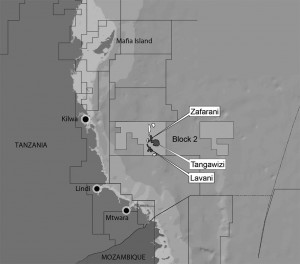Roger Nellist, the latest volunteer to join our panel of contributors reports as follows on an announcement by Statoil of their third big gas discovery offshore Tanzania:
On 18 March 2013 Statoil and its co-venturer ExxonMobil gave details of their third high-impact gas discovery in licence Block 2 in a year. The new discovery (known as Tangawizi-1) is located 10 kilometres from their first two discoveries (Lavani and Zafarani) made in 2012, and is located in water depth of 2,300 metres. The consortium will drill further wells later this year.
The Tangawizi-1 discovery brings the estimated total volume of natural gas in-place in Block 2 to between 15 and 17 trillion cubic feet (Tcf). Depending on reservoir characteristics and field development plans, this could result in recoverable gas volumes in the range of 10-13 Tcf from just this one Block. These are large reserves by international standards. By comparison, Tanzania’s first gas field at Songo Songo island has volumes of about 1 Tcf.
Statoil has been in Tanzania since 2007 and has an office in Dar es Salaam. It operates the licence on Block 2 on behalf of the Tanzania Petroleum Development Corporation (TPDC) and has a 65% working interest, with ExxonMobil Exploration and Production Tanzania Limited holding the remaining 35%. It is understood that under the Production Sharing Agreement that governs the operations, TPDC has the right to a 10% working participation interest in case of a development phase.
Commenting on the Tangawizi-1 announcement, the Tanzanian Minister for Energy and Minerals, Hon. Professor Sospeter Muhongo, said “The Tanzania Government is pleased to learn about additional gas resources discovered in Block 2 and remains optimistic on future developments”.
The Block 2 discoveries complement other recent gas discoveries made by the BG Group. The investors and the Government have both domestic gas utilisation and large-scale exports in mind.
For more information see: http://www.statoil.com/en/NewsAndMedia/ News/2013/Pages/18Mar_Tanzania.aspx
Great expectations
In February Samuel Kamndaya, the Citizen’s Business Editor, published some very useful background. Extracts:
‘Come 2023, natural gas will contribute up to 35% of the total market value of officially recognised final goods and services produced in Tanzania, analysts say. But that will happen only after companies that are prospecting for natural gas in the deep sea south of Tanzania get enough finds to attract investors into developing a Liquefied Natural Gas (LNG) facility for dissolving the hydrocarbon product for an export market. Getting to that stage, analysts caution, requires a great deal of patience, commitment, predictability and information sharing among key stakeholders–including the government, investors and wananchi, considering the massive investment required to realise the dream.
“You need a great deal of time, expertise and investment before bringing such a project to fruition,” said the BG Tanzania head of policy and corporate affairs, Fred Kibodya. “Developing an LNG project requires a massive investment of not less than $15 billion in the region.” His Statoil Tanzania counterpart, Ms Genevieve Kasanga, puts the estimated investment in setting up an LPG project in the region of $20 billion.
Tanzania’s GDP now stands at $23 billion. A 35% contribution to GDP, at the current rates, translates into an input of $8.1 billion. This is close to Tanzania’s entire budget of TShs 15.1 trillion (about $9.5 billion) for the current financial year. Agriculture contributes about 24% to Tanzania’s GDP and tourism comes second with a contribution of about 17%. If the country’s current economic growth projection of 6.5% is sustained, and a clear linkage is built between natural gas and the manufacturing and agriculture sectors, Tanzania should graduate into a middle income country.
“The fact that natural gas may bring economic fortunes to Tanzania can in no way be underestimated,” says Prof Humphrey Moshi of the University of Dar es Salaam. “But we should not expect wonders if there is no linkage between the sector and other dynamic sectors such as industries and agriculture.”
But Mtwara is not happy
The prospect of sending the gas by pipeline to Dar es Salaam for use by new industries there has caused considerable upset in Mtwara. People there want new industrial plants to be built in Mtwara, where the gas will come ashore, rather than in Dar es Salaam. There have been violent demonstrations in Mtwara, reportedly supported by Mtwara Urban CCM MP Hasnain Murji.
In early February, the Citizen quoted Mr Murji, who has publicly differed with the position of his party on transporting gas to Dar es Salaam, as calling for a Select Committee to probe controversies surrounding the matter. He asked for the Speaker’s directive on why Parliament had failed to form a committee as had been agreed earlier. House chairperson, Mrs Jenister Muhagama, said nothing could be done because the Speaker, Ms Anne Makinda, had already ruled on the matter. Parliament eventually dropped the idea of forming a select-committee because it was satisfied with the Prime Minister’s handling of the matter.

